The EVGA Z590 Dark Motherboard Review: For Extreme Enthusiasts
by Gavin Bonshor on October 15, 2021 9:00 AM ESTVisual Inspection
Opting for a unique and unconventional set of design characteristics, the EVGA Z590 Dark is primarily geared for extreme overclocking. This includes a transposed LGA1200 socket with plenty of space for users to mount an LN2 pot, as well as adopting right-angled connectors throughout, including power connectors and fan headers. Looking at fan headers, there are six in total, with two designated for CPU fans and six for chassis fans or water pumps. EVGA includes an RGB LED logo on the rear panel cover, with two ARGB and two RGB headers onboard for users to add external LED strips.
Dominating the lower portion of the board is a set of large black heatsinks and the board's PCIe slots. EVGA includes two full-length PCIe 4.0 slots that can operate at x16 and x8/x8, with one half-length slot electronically locked down to PCIe 3.0 x4. In between the full-length slots is a trio of M.2 slots, one with support for super-fast PCIe 4.0 x4 NVMe drives, one limited to PCIe 3.0 x4, and the other limited to PCIe 3.0 x4/SATA. The third M.2 slot shares bandwidth with the bottom full-length PCIe 3.0 x4/SATA slot.
Other storage options include one PCIe 3.0 x4 U.2 slot for stackable storage and eight SATA ports. Six of the SATA ports support Intel RAID 0, 1, 5, and 10 arrays, while an ASMedia ASM1061 SATA controller powers the other two.
Looking at DRAM support, the EVGA Z590 Dark has two horizontally mounted memory slots above the LGA1200 socket, which is designed to bolster the overclocking ability. The two memory slots can support up to DDR4-5333 out of the box with a maximum capacity of up to 64 GB. Not only this, but it allows extreme overclockers better access to the CPU socket.
EVGA also includes an extensive overclocker's toolkit, which is primarily located along the top edge of the board. A power and reset button pairing is included, with a 3-way BIOS selector switch as the Z590 Dark comes with three BIOS ROM chips. Also included is a set of PCIe dip switches that allow users to enable or disable them, as well as a small clear CMOS button.
Focusing on the power delivery on the EVGA Z590 Dark, it is equipped with a sizable 21-phase power delivery which is split into 16+1+1. There are sixteen Renesas ISL99390 90 A smart power stages dedicated to the CPU VCore, which are doubled up using eight Renesas ISL6617 doublers. This means the CPU VCore section is technically an 8-phase design, so the power delivery operates at 8+1+1. This is a slight stretch labeling it as 21-phases. In essence, it is, but the CPU VCore is using a doubled 8-phase design.
EVGA also includes a pair of ON Semiconductor NTMFS4C05N high side and NTMFS4C10N low side MOSFETs for the VCCIO2 voltage, one Renesas ISL99360 60 A power stage for the VCCSA, one and one ISL99360 A power stage for VDDR voltage. Overall it's a pretty comprehensive power delivery and one that has been designed with extreme overclocking in mind. The CPU socket also uses the flatter tantalum capacitors, which stop obstructions when mounting an LN2 pot.
Keeping the power delivery cool is a large pair of heatsinks that are interconnected to the chipset heatsink via a single heat pipe. Helping keep things running cool is a pair of 40 mm cooling fans that vent the air out via the rear of the I/O shield.
The Z590 Dark uses a Realtek ALC1220 HD audio codec with an assisting EVGA NU SV3H615 amplifier for integrated audio. EVGA is also using four large yellow Bennic Bi-Polar audio capacitors, which are premium quality. The ALC1220 HD audio codec omits any EMI shielding, and EVGA uses a line of separation from the rest of the board's components.
EVGA includes one USB 3.2 G2x2 Type-C, four USB 3.2 G2 Type-A, and two USB 3.2 G1 Type-A ports on the rear panel. The Realtek ALC1220 HD audio codec and EVGA NU SV3H615 power five 3.5 mm audio jacks and S/PDIF optical output, while an HDMI 2.0b and DisplayPort 1.4 video output pairing provide integrated graphics support. Networking support consists of two RJ45 ports powered by individual Intel I225-V 2.5 GbE controllers, with an Intel AX201 Wi-Fi 6 CNVi delivers both wireless and BT 5.2 connectivity. Finishing off the rear panel is a PS/2 combo port and a small clear CMOS button.
What's in The Box
The accessories bundled with the EVGA Z590 Dark include two Probelt voltage monitoring cables, three M.2 thermal pads, and screws, as well as an Intel AX201 Wi-Fi 6 antenna set. It wouldn't be a motherboard accessories bundle without SATA cables which EVGA provides four, and an EVGA case badge and a small USB flash drive with the board's software and drivers.
EVGA also includes a printed backboard that allows users to set a system up like a test bench, which also has a visual map of the board's components. Also included are ten long standoffs and ten screws to allow users to install the motherboard onto the backboard.
- Quick installation guide
- Bench table stand
- 10 x standoffs and screws
- Intel Wi-Fi 6 antenna
- Driver/software installation USB drive
- 4 x SATA cables
- 3 x M.2 thermal pads
- 2 x Probelt OC cables
- EVGA case badge


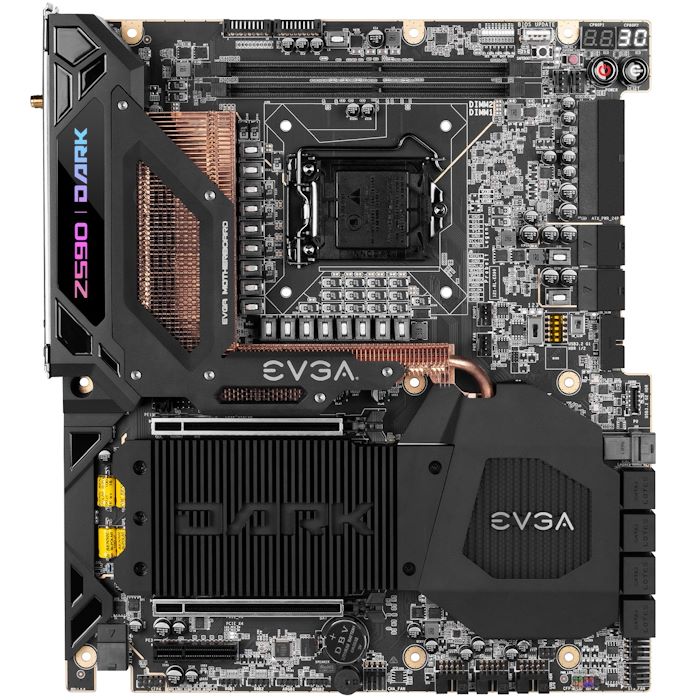
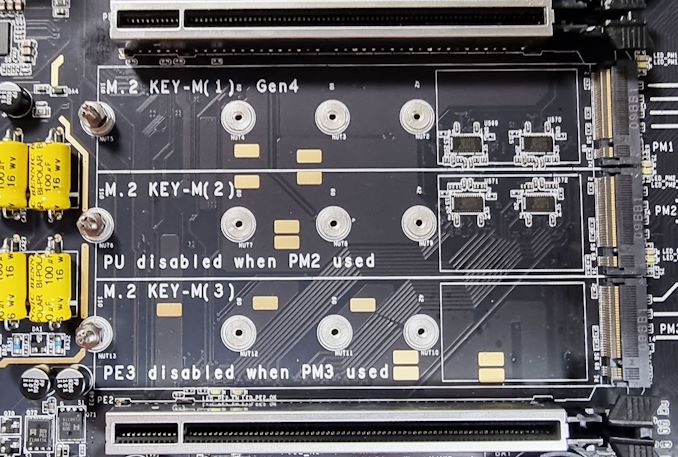

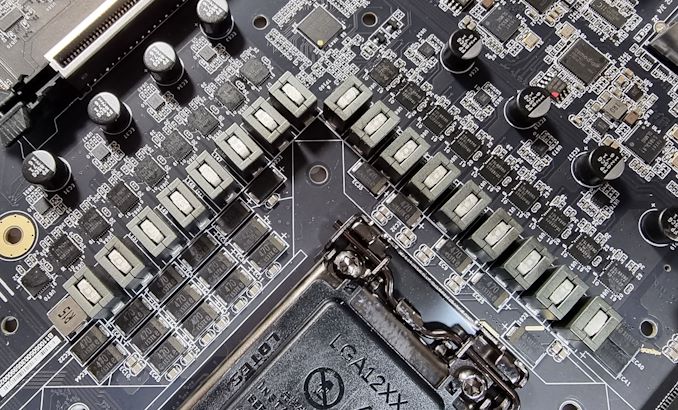
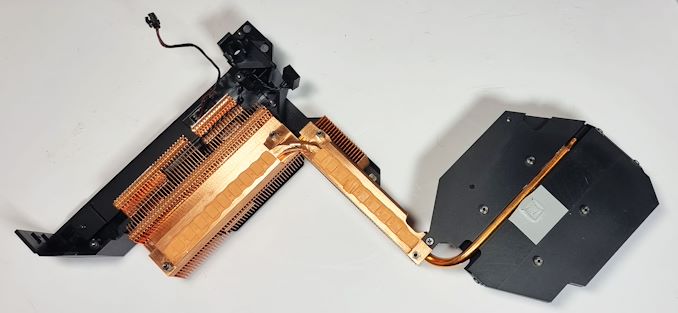

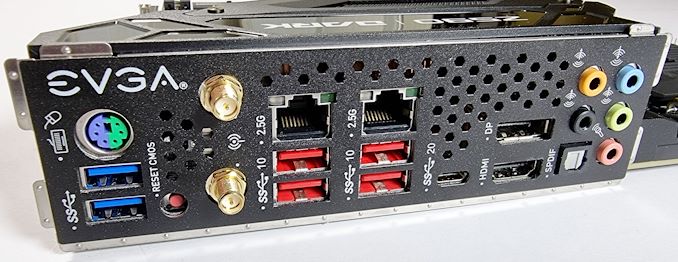
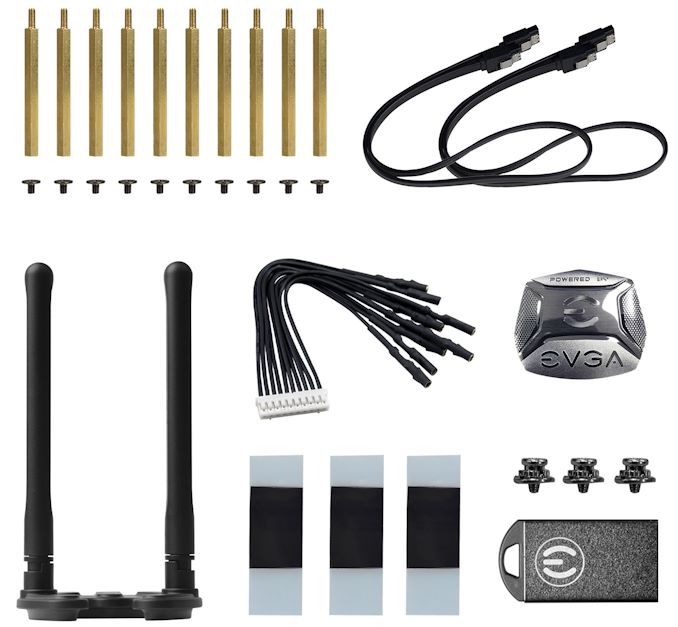








27 Comments
View All Comments
YB1064 - Friday, October 15, 2021 - link
If this board is built for LN2 overclocking, then a review without testing this capability is incomplete. Come on guys, you used to do this in the past. What gives?Ryan Smith - Friday, October 15, 2021 - link
Speaking pragmatically, when we do that kind of testing, we're at serious risk of burning out a $500 CPU. For a comprehensive overclocking-focused article that may make sense, but for single motherboard review that's not a very good use of our resources.To be sure, it would be fun to do - and ideally I'd like to make it happen. But there are some niche features/configurations that even we can't justify the cost of testing.
niva - Friday, October 15, 2021 - link
Do people actually run their systems with LN2 cooling? Or is it something that just exists to be used temporarily when doing extreme benchmarks?I've been building PCs since the 90s and never even bothered with liquid coolers, never mind LN2. Seems like a complete gimmick and as you stated, risky. Not just for the CPU resources, but potentially dangerous to the people setting up the system.
shabby - Friday, October 15, 2021 - link
If it's targeted for ln2 that means they can charge a pretty penny for it, that's all it means.Ryan Smith - Friday, October 15, 2021 - link
You're correct: no one is using LN2 on a day-to-day basis. It's mostly for short use periods for extreme overclocking.amnesia0287 - Friday, October 15, 2021 - link
The stuff they change to make it work with LN2 still benefit everyone else, just less. Cause basically what they do is swap in higher quality chips that are better hardened. They tighten up the tolerances (which is why it’s only got 2 ram slots, to make the traces shorter and more consistent).Same with the upgrade to the power delivery and pci traces.
Can a human tell the difference from any of these things? No way, but they will certainly help a cpu last longer and run more stable. It just doesn’t make sense to spend on any current pc hardware with all the changes about to pop off. Just pci5 and the addition of cxl are gonna be huge.
Oxford Guy - Saturday, October 16, 2021 - link
‘Extreme overclocking’ = extreme marketing techniquefrozen_water - Friday, October 15, 2021 - link
Meh, having owned the z490 dark kp edition I think these boards are way overrated. Does this one still have a silkscreen URL for a non-existent TiN guide? Does this still not support Intel’s cryo/TEC coolers? It’s literally the most expensive oc motherboard out there and it lacks features that other much cheaper ones have.Silver5urfer - Friday, October 15, 2021 - link
Unfortunately TiN is retired from EVGA. He moved to US I guess due to family. Now those nice amazing articles on Xdevs are nowhere since Z490 series. The only person now covering this extensively is Luumi. Check his content, he also makes Win7 installs just like TiN as well.I'm eying this board with 10900K or X570 DARK if the AMD board also drops USB then I'm skipping Ryzen.
amnesia0287 - Friday, October 15, 2021 - link
OC motherboards mostly all a waste of money for most people. But just looking at the vrms, power delivery, tight uniform ram traces and such. They are extremely focused on pure electrical stability/consistency/reliability. Though certainly not to the same degree, it is built similarly to military hardened pc gear in some ways.